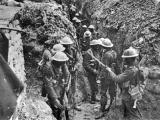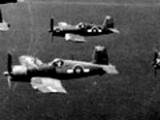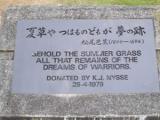About 4500 New Zealand servicemen arrived as part of a 36,000-strong British Commonwealth Occupation Force that was to work alongside the US military forces that had occupied most of Japan.
Japanese
Events In History
Air Vice-Marshal Leonard Isitt added New Zealand’s signature to the Instrument of Surrender between the Allied powers and Japan.
Japan's surrender following the atomic bombing ofHiroshima and Nagasaki ended the Second World War. More than 200,000 New Zealanders had served during the war and more than 11,500 had died.
New Zealanders of 8 Brigade, 3 New Zealand Division, helped their American allies clear Mono Island in the Solomons of its Japanese defenders. Forty lost their lives in weeks of fierce fighting.
The announcement by the Prime Minister’s Department that New Zealand was in a state of war with Japan followed the surprise attack on the United States naval base at Pearl Harbor, Hawaii. Japan also attacked Hong Kong, the Philippines, Thailand and Malaya.
Articles
VE and VJ days

After over five years of rationing and anxiety about loved ones overseas, New Zealanders greeted the coming of peace in Europe in May 1945, and then victory over Japan in August, with understandable relief and enthusiasm. Read the full article
Page 3 - VJ Day
VJ Day, like VE Day, showed public regulation at work. Again the preparation had been considerable, and this time celebrations went more smoothly
First World War - overview

Archduke Franz Ferdinand, heir to the throne of the Austro-Hungarian Empire, and his wife Sophie were assassinated in the Bosnian city of Sarajevo. This was a key event in sparking the Great War of 1914–18. Read the full article
Page 4 - New Zealand goes to war
Before the outbreak of war, Prime Minister W.F. Massey had made it clear that New Zealand’s main contribution would be supplying troops to the major theatre of conflict. But
War in the Pacific

Thousands of New Zealanders fought in the Pacific War, which was sparked by the Japanese bombing of the American naval base at Pearl Harbor on 7 December 1941. It was a conflict fought on a vast scale over huge distances. For the New Zealanders, this was a war fought close to home. Read the full article
Page 2 - The war against Japan
United States President Franklin D. Roosevelt described it as 'a date which will live in infamy' - 7 December 1941, the day the Japanese bombed the American naval base at Pearl
Page 4 - The final stages
Once the tide had turned in favour of the United States and its allies, American troops began 'island hopping' through the central Pacific, taking one island after another.
Featherston incident

Two kilometres north of the quiet little Wairarapa town of Featherston a small memorial garden marks the site of a riot that resulted in the deaths of 48 Japanese prisoners of war and one guard. Read the full article
Page 1 - Incident at Featherston
Two kilometres north of the quiet little Wairarapa town of Featherston a small memorial garden marks the site of a riot that resulted in the deaths of 48 Japanese prisoners of war
Allies
The military alliance that fought against the Central Powers was known as the Allies. Initially this alliance was based around the four great powers of Russia, France, Japan and the British Empire, along with the smaller states of Serbia, Montenegro and Belgium that also went to war in 1914. Read the full article
Page 6 - Empire of Japan
Key information and statistics about the Empire of Japan during the First World
Royal NZ Navy's Bird-class ships
October 2011 marks the 70th anniversary of the formation of the Royal New Zealand Navy. In 1941 the new navy had three brand-new ships – the Moa, Kiwi and Tui – working up or fitting out in Scotland. These little Bird-class minesweepers would see dramatic action in the Pacific War. Read the full article
Page 4 - Moa and Kiwi bag a sub
On the night of 29 January Kiwi and Moa were patrolling along Kamimbo Bay, on the north-western corner of Guadacanal when Kiwi detected a

















